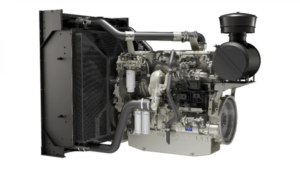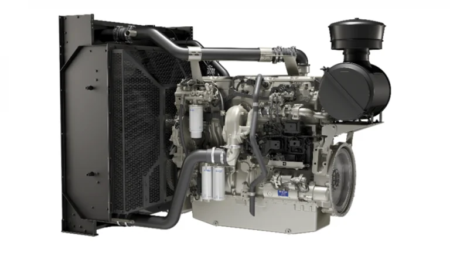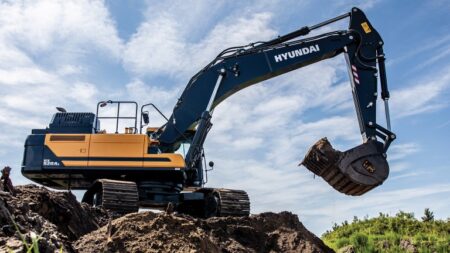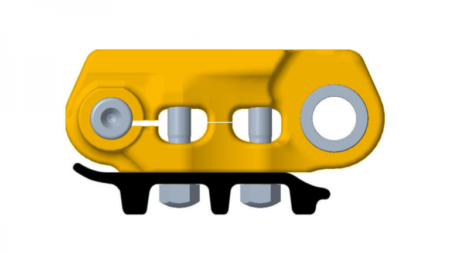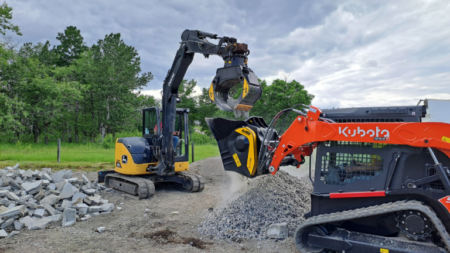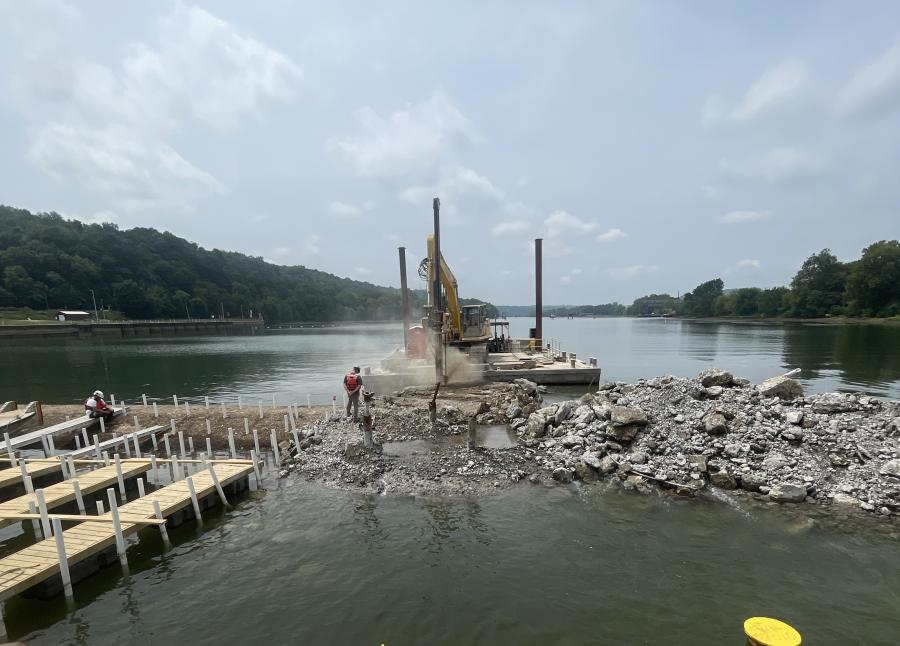
Photo courtesy of Fay, S&B USA Construction
The John Henry drills holes for the explosives to be loaded into.
Fay, S&B USA Construction (Fay) recently started construction on a $29.6 million contract to demolish the Monongahela River Lock and Dam No. 3 (LD3) in Elizabeth, Pa.
The project is the latest in an ongoing series of efforts by the US Army Corps of Engineers (USACE) to improve the Monongahela River navigation system.
The USACE has been working on the three oldest currently operating facilities on the Monongahela River since 1992. They were first constructed to help coal barges and other traffic navigate the river. The USACE has collaborated with various contractors, including Fay, to perform upgrades to the Braddock and Charleroi (soon to be renamed John P. Murtha) locks and dams.
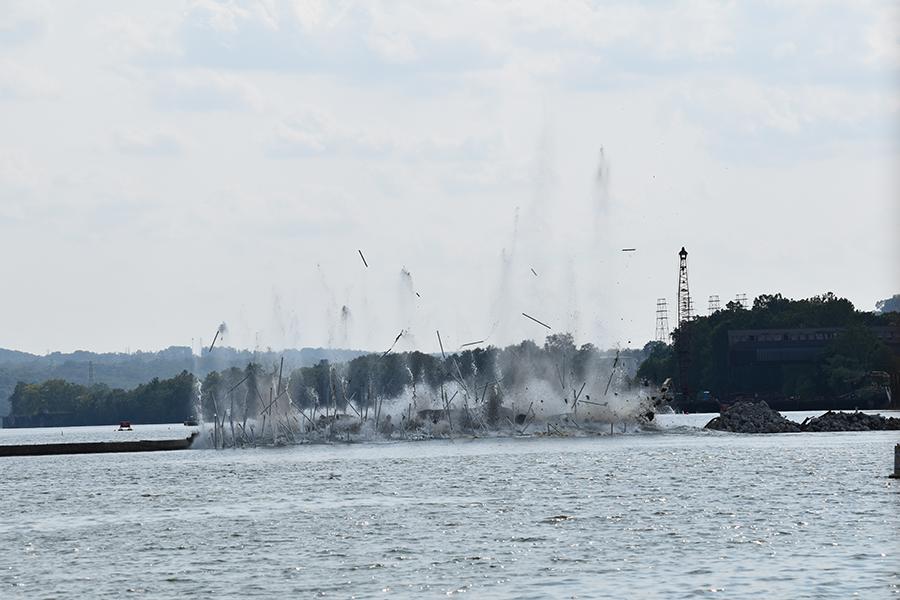
Photo courtesy of Fay, S&B USA Construction
Fay reported that with these upgrades, the LD3 is no longer needed to address the volume of river traffic, so it has been scheduled for demolition. This will create a larger unrestricted pool for recreational boaters to access. It also will save time and money — an estimated $200 million annually — transporting materials up and down the river.
This project includes work associated with Monongahela River Locks and Dam No. 3 demolition, establishment of the new navigable channel and stabilization of the monoliths to remain after construction.
Fay will breach the existing dam for pool equalization; demolish several structures, including dam No. 3, the middle wall, the river wall, the upper guard wall cells and the river chamber extension cells. Stability berms will then be placed within the land chamber adjacent to the land wall and left dam abutment. Afterwards, Fay will install permanent stabilization measures for the flume way, land wall, upper guide walls and dam abutment.
According to Fay, the dam is being removed using a combination of demolition techniques. Most of the work will reportedly be performed by 25 to 50 Fay employees in-house. The explosives are the exception and will be done by a specialized subcontractor.
Fay began mobilizing its marine fleet starting in April 2024. Matt Kravets, Fay’s senior project manager, said that Fay starts the demolition sequence by using a John Henry drill mounted on an excavator to “drill about a 50-ft.-wide section at a time using a 3 ft. by 4 ft. hole pattern.” The dam is 683 ft. in total.
Once the holes are drilled, tubes are used to load explosives into each hole on the morning of the implosion.
“There will be between 12 to 14 implosions on this portion of the project,” Kravets said.
When the explosives have been placed, he explained that everything is then tied together into one big series. Fay contractors then ensure their security perimeter has been established before performing the implosion. This is 500 ft. from the location of the explosives on land, and 1,500 ft. up and down the river.
Following the first implosion, Fay paused demolition efforts for several days while the upper and lower pools of water equalized 2 ft. each, allowing mussels to relocate in response to the new water level. Afterwards, Fay broke down larger pieces of rubble using a hydraulic impact breaker, cleared up any remaining rubble using a Manitowoc 4000 crane equipped with a clam bucket and barged it to shore for processing.
“In the future, the processed material will be brought back from the laydown yard to the river for use as stability berms for the walls that remain,” Kravets said.
This process will be repeated until the entire length of the dam has been demolished. Once the riverway has been cleared, marine traffic will be permitted to travel through the area without using the lock chamber, which will be demolished in a similar manner beginning in 2025.
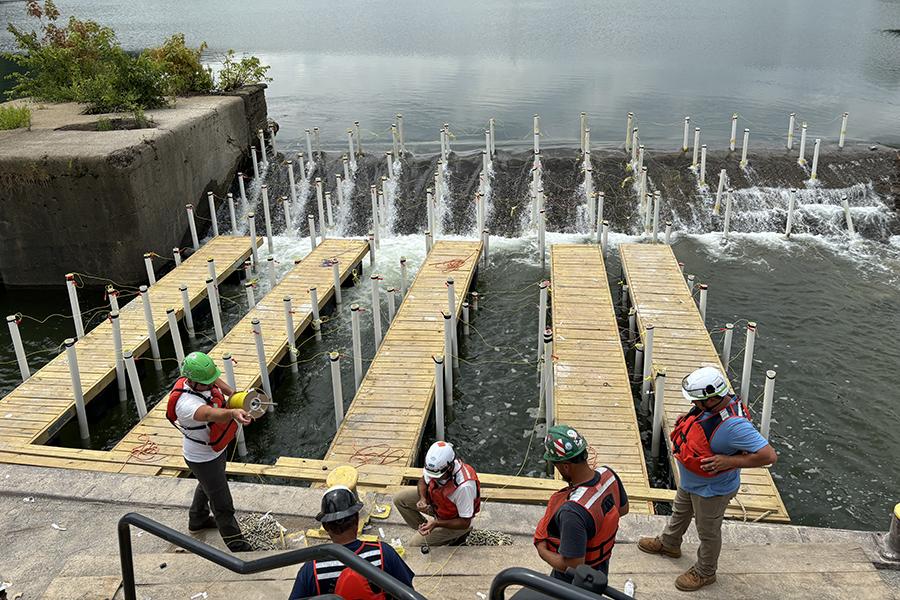
Photo courtesy of Fay, S&B USA Construction
Upon completion, Fay reported that this project will have a positive impact on local businesses that rely on the river to conduct business. With the lock and dam eliminated, boats and barges will be able to move unrestricted through a longer stretch of river, enabling them to make deliveries faster. The larger pool will provide greater stability of river elevations, which is also a positive impact to local businesses.
This project also will include the construction and opening of the new navigable channel. Once the Monongahela River Locks and Dam No. 3 has been demolished, Fay will survey 300 ft. upstream and 600 ft. downstream of the removed dam to locate material above the required demolition elevation. If any high spots are located, Fay will dredge the new channel to remove them.
Once the new navigable channel is open, the land and river chambers will be permanently closed for the demolition of the river and middle wall. The project will be finished with the placement of stability berms on the river face of the land wall, filling the flume way and placing a new concrete cap on the esplanade.
The first blast was scheduled for July 8 and complete dam removal and opening of the new navigation channel is expected to happen by Dec. 4, 2024. Afterwards, Fay will continue to remove the middle and river walls, fill the flume way, place the stability berm along land wall and new concrete cap on the esplanade. All contract work is scheduled to be complete by Nov. 20, 2026.
As part of its ongoing safety efforts on site, Fay coordinates heavily with the USACE and the Coast Guard on this project.
About Locks and Dam 3
According to USACE, Locks and Dam 3 is one of nine navigation structures that provide for year-round navigation on the Monongahela River between Pittsburgh, Pa., and Fairmont, W. Va. It maintains a pool for 23.8 mi. above the mouth of the Youghiogheny River, just above Elizabeth, Pa.
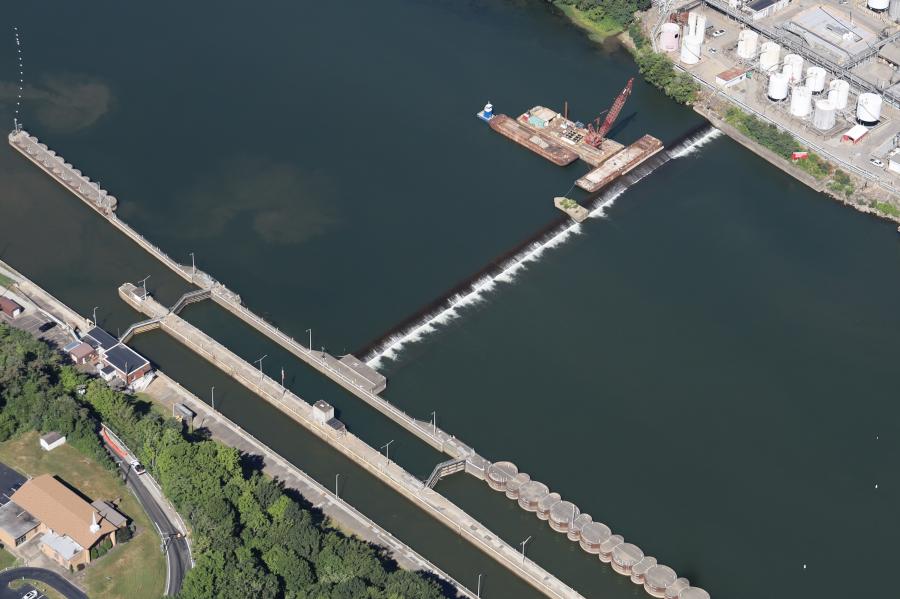
Photo courtesy of Fay, S&B USA Construction
Locks and Dam 3 consists of two lock chambers and a fixed crest dam. This type of dam is basically a concrete weir or wall across the river which keeps the river channel upriver of the project deep enough for navigation — approximately 9 ft. or more. Water that flows over this type of dam cannot be controlled locally. Consequently, it cannot provide any control over flood waters. An incidental benefit derived from the pool formed by the dam is the availability of a source of municipal and industrial water.
Construction of Locks and Dam 3 at this present site began in 1905 and completed in 1907. After some 70 years of use, a major rehabilitation of the project, the busiest on the Mon River, was completed in 1980. This work involved reconstruction of the lock chambers.
Locks and Dam 3 is located at river mile 23.8 at the city of Elizabeth. The lock chambers and operations buildings are situated along the right bank of the river adjacent to a main line of Pittsburgh and Lake Erie Railroad. Road access to the project is from a local road going south out of Elizabeth. CEG
Brenda Ruggiero
Brenda Ruggiero has written for CEG for over 20 years. She lives near the town of Accident in far western Maryland. Her favorite assignments so far involved interviews with Survivor’s Boston Rob and hot dog eating champion Joey Chestnut. Both were involved in construction at one time.
Brenda holds a BA in Mass Communication with a writing focus from Frostburg State University and minors in Public Relations and Political Science. She works full time as a staff writer for a weekly newspaper, the Garrett County Republican. She enjoys feature writing the most, which gives her the opportunity to talk to people and share their stories.
Brenda and her middle school sweetheart, Reuben, have been married for over 34 years and have three grown children and four cats.
Read the full article here


